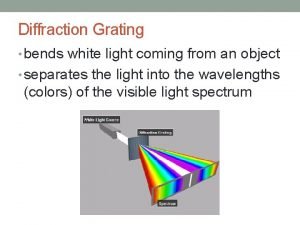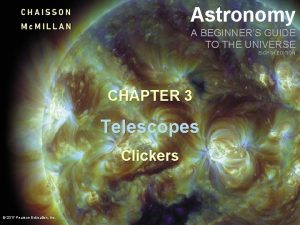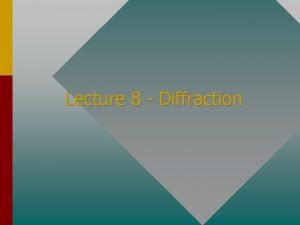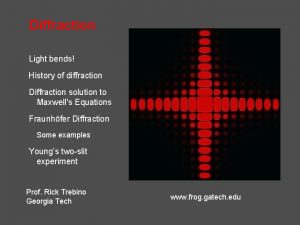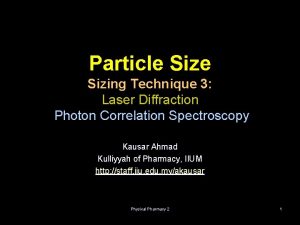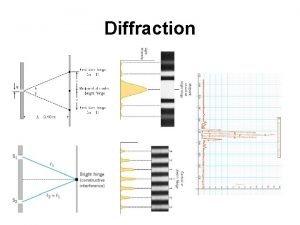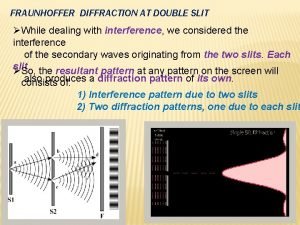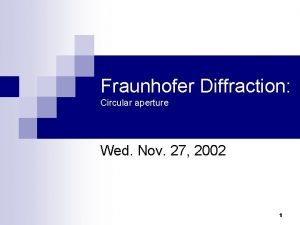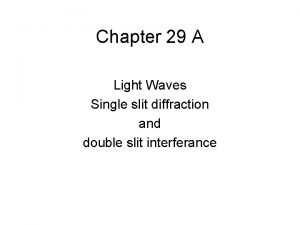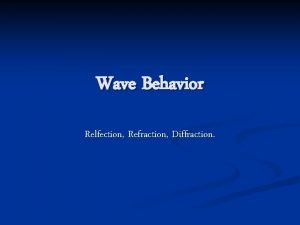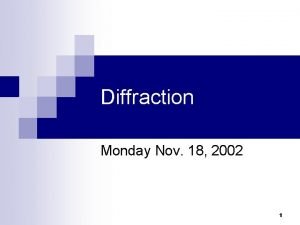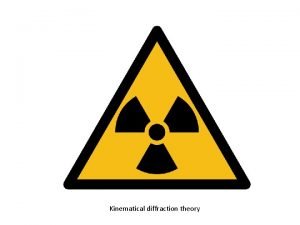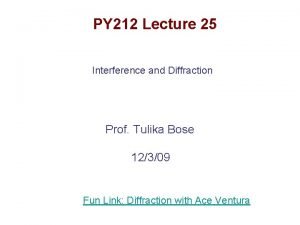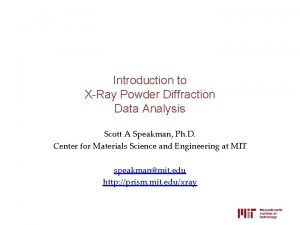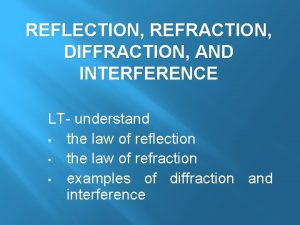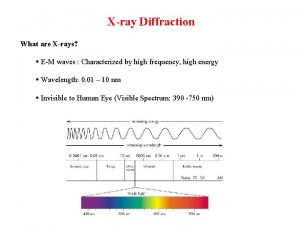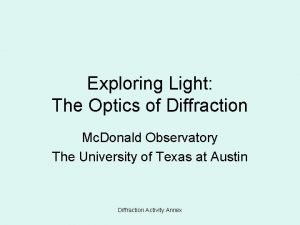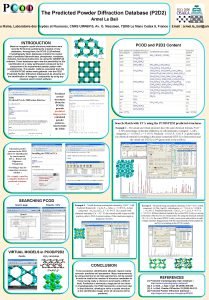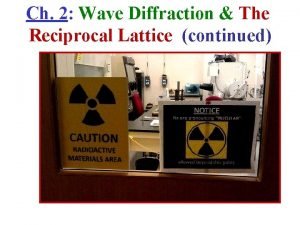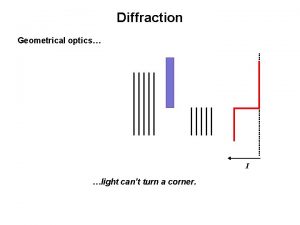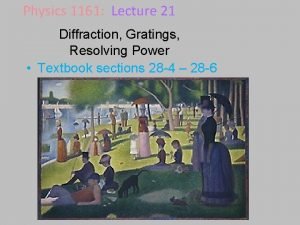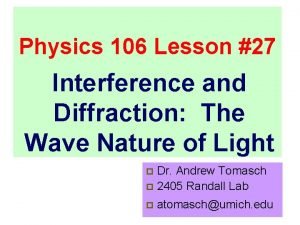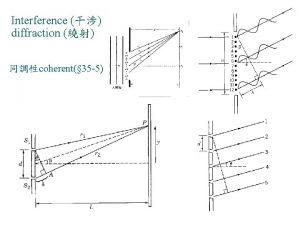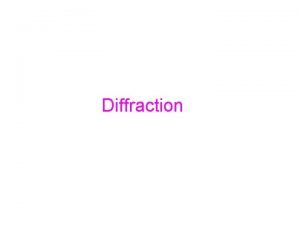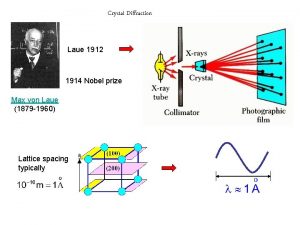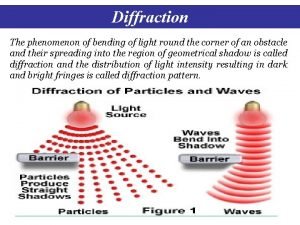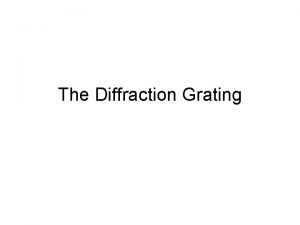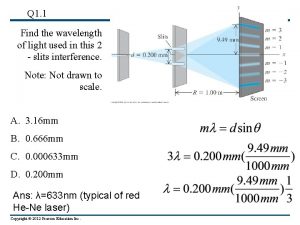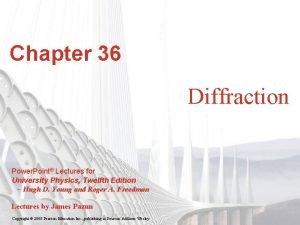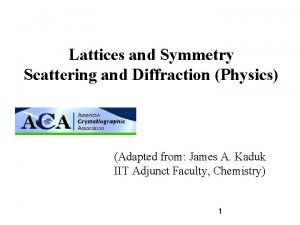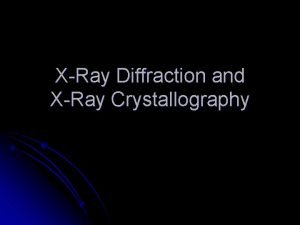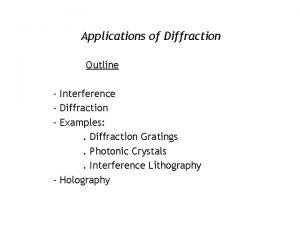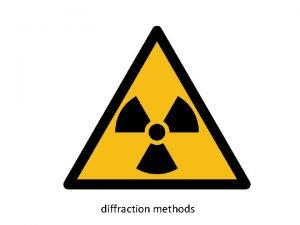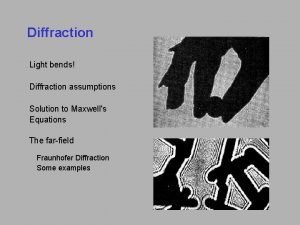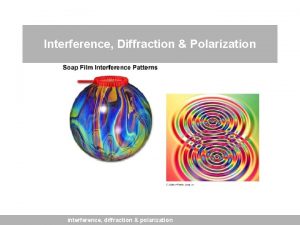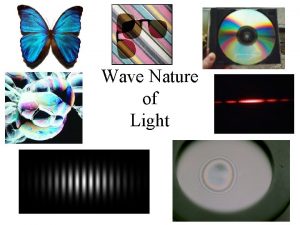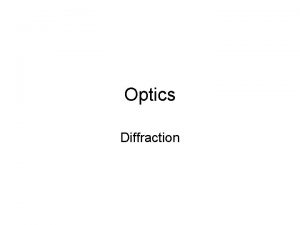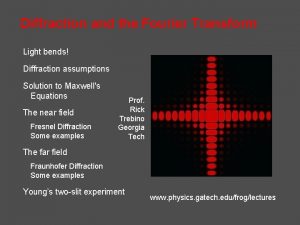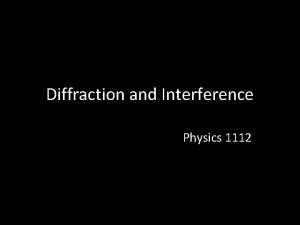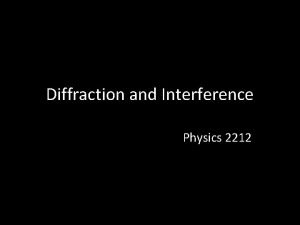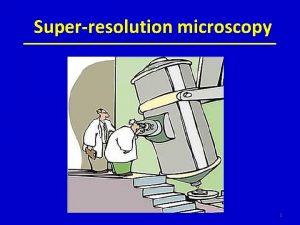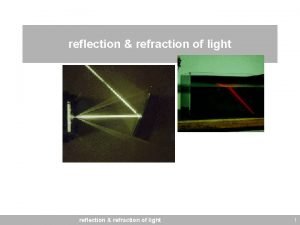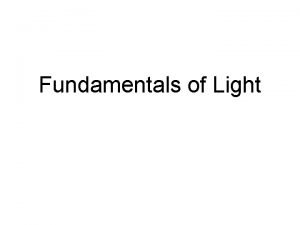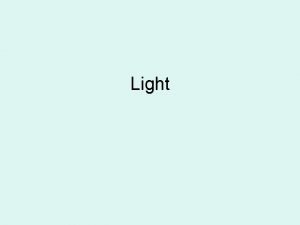Lecture 8 Diffraction Diffraction of Light Diffraction is
















































- Slides: 48

Lecture 8 - Diffraction

Diffraction of Light Diffraction is the ability of light waves to bend around obstacles placed in their path. Ocean Beach Light rays Fuzzy Shadow Water waves easily bend around obstacles, but light waves also bend, as evidenced by the lack of a sharp shadow on the wall.

Wave bends as it passes an obstacle.

Water Waves A wave generator sends periodic water waves into a barrier with a small gap, as shown below. A new set of waves is observed emerging from the gap to the wall.

Interference of Water Waves An interference pattern is set up by water waves leaving two slits at the same instant.

Young’s Experiment In Young’s experiment, light from a monochromatic source falls on two slits, setting up an interference pattern analogous to that with water waves. Light source S 1 S 2

The Superposition Principle • The resultant displacement of two simultaneous waves (blue and green) is the algebraic sum of the two displacements. • The composite wave is shown in yellow. Constructive Interference Destructive Interference The superposition of two coherent light waves results in light and dark fringes on a screen.

Young’s Interference Pattern s 1 Constructive Bright fringe s 2 s 1 Destructive Dark fringe s 2 Constructive Bright fringe

Conditions for Bright Fringes Bright fringes occur when the difference in path Dp is an integral multiple of one wave length . p 1 p 2 p 3 p 4 Path difference Dp = 0, , 2 , 3 , … Bright fringes: Dp = nl, n = 0, 1, 2, . . .

Conditions for Dark Fringes Dark fringes occur when the difference in path Dp is an odd multiple of one-half of a wave length /2. p 1 p 2 p 3 Dark fringes: n = odd n= 1, 3, 5 …

If two waves go through the slit and then proceed straight ahead to the screen, they both cover the SAME DISTANCE and thus will have constructive interference. Their amplitudes will build and leave a very bright intense spot on the screen. We call this the CENTRAL MAXIMUM.

Figure 2 Figure 1 Notice we have additional bright spots, yet the intensity is a bit less. We denote these additional bright spots as ORDERS. So the first bright spot on either side of the central maximum is called the FIRST ORDER BRIGHT FRINGE. Figure 1 represents the intensity of the orders as we move farther from the bright central maximum.

We use the letter, m, to represent the ORDER of the fringe from the bright central. Second Order First Order Bright Fringe Central. First Order Bright Fringe m = 2 m=2 Maximum m=1

l Notice that these 2 waves are IN PHASE. When they hit they screen they both hit at the same relative position, at the bottom of a crest. The call this extra distance the PATH DIFFERENCE. The path difference and the ORDER of a fringe help to form a pattern. Exactly – ONE WAVELENGTH

2 l 2 l 1 l 1 l P. D. = ml The bright fringes you see on either side of the central maximum are multiple wavelengths from the bright central. And it just so happens that the multiple is the ORDER. (Constructive)

Analytical Methods for Fringes x s 1 d q s 2 Path difference determines light and dark pattern. d sin q p 1 p 2 y Dp = p 1 – p 2 Dp = d sin q Bright fringes: d sin q = nl, n = 0, 1, 2, 3, . . . Dark fringes: d sin q = nl/2 , n = 1, 3, 5, . . .

Analytical Methods (Cont. ) s 1 d q s 2 From geometry, we recall that: x d sin q p 1 p 2 Bright fringes: y So that. . . Dark fringes:

Example 1: Two slits are 0. 08 mm apart, and the screen is 2 m away. How far is the third dark fringe located from the central maximum if light of wavelength 600 nm is used? x = 2 m; d = 0. 08 mm = 600 nm; y = ? d sin = 5( /2) The third dark fringe occurs when n = 5 Dark fringes: x s 1 s 2 q d sin q n = 1, 3, 5 y

Example 1 (Cont. ): Two slits are 0. 08 mm apart, and the screen is 2 m away. How far is the third dark fringe located from the central maximum if = 600 nm? x x = 2 m; d = 0. 08 mm s 1 d sin q = 600 nm; y = ? q s 2 y n = 1, 3, 5 y = 3. 75 cm

Diffraction Grating

The Diffraction Grating A diffraction grating consists of thousands of parallel slits etched on glass so that brighter and sharper patterns can be observed than with Young’s experiment. Equation is similar. d sin q d sin = nl n = 1, 2, 3, …

The Grating Equation The grating equation: d = slit width (spacing) l = wavelength of light q = angular deviation n = order of fringe 3 2 1 st order 6 4 2 2 nd order

Example 2: Light (600 nm) strikes a grating ruled with 300 lines/mm. What is the angular deviation of the 2 nd order bright fringe? To find slit separation, we take reciprocal of 300 lines/mm: Lines/mm mm/line n=2 300 lines/mm

Example (Cont. ) 2: A grating is ruled with 300 lines/mm. What is the angular deviation of the 2 nd order bright fringe? = 600 nm n=2 300 lines/mm Angular deviation of second order fringe is: q 2 = 21. 10

Example A light with wavelength, 450 nm, falls on a diffraction grating (multiple slits). On a screen 1. 80 m away the distance between dark fringes on either side of the bright central is 4. 20 mm. a) What is the separation between a set of slits? b) How many lines per meter are on the grating? 0. 067 degrees 0. 0001924 m 5197. 2 lines/m

A compact disk acts as a diffraction grating. The colors and intensity of the reflected light depend on the orientation of the disc relative to the eye.

Interference From Single Slit When monochromatic light strikes a single slit, diffraction from the edges produces an interference pattern as illustrated. Relative intensity Pattern Exaggerated The interference results from the fact that not all paths of light travel the same distance some arrive out of phase.

Single Slit Interference Pattern Each point inside slit acts as a source. For rays 1 and 3 and for 2 and 4: a/2 a a/2 1 2 3 4 5 First dark fringe: For every ray there is another ray that differs by this path and therefore interferes destructively.

Single Slit Interference Pattern First dark fringe: a/2 a a/2 1 2 3 4 5 Other dark fringes occur for integral multiples of this fraction l/a.

Example 3: Monochromatic light shines on a single slit of width 0. 45 mm. On a screen 1. 5 m away, the first dark fringe is displaced 2 mm from the central maximum. What is the wavelength of the light? =? x = 1. 5 m a = 0. 35 mm = 600 nm y

Diffraction for a Circular Opening D Circular diffraction The diffraction of light passing through a circular opening produces circular interference fringes that often blur images. For optical instruments, the problem increases with larger diameters D.

Resolution of Images Consider light through a pinhole. As two objects get closer the interference fringes overlap, making it difficult to distinguish separate images. Clear image of each object d 1 Separate images barely seen d 2

Resolution Limit Images are just resolved when central maximum of one pattern coincides with first dark fringe of the other pattern. Separate images Resolution limit d 2 Resolution Limit

Resolving Power of Instruments The resolving power of an instrument is a measure of its ability to produce well-defined separate images. D Limiting angle For small angles, sin , and the limiting angle of resolution for a circular opening is: Limiting angle of resolution:

Resolution and Distance p so D Limiting angle o Limiting Angle of Resolution:

Example 4: The tail lights ( = 632 nm) of an auto are 1. 2 m apart and the pupil of the eye is around 2 mm in diameter. How far away can the tail lights be resolved as separate images? p so Tail lights D Eye p = 3. 11 km

Using a diffraction grating to measure the wavelength of light • A spectrometer is a device to measure wavelengths of light accurately using diffraction grating to separate. Turntable Collimator C Diffraction grating θ Light source Achromatic lenses Telescope T Eyepiece Cross-wire Eye

Grating Equation Two parallel monochromatic rays strike adjacent grooves and are diffracted at the same angle (b). Difference in optical pathlength is AC + AD. For constructive interference: m = (AC + AD) m = 0, 1, 2, 3, … Ingle and Crouch, Spectrochemical Analysis

Grating Equation m = (AC + AD) AC = d sin a AD = d sin b Combine to give Grating Equation: d(sin a + sin b) = m Grating Equation only applies if: d > /2 Ingle and Crouch, Spectrochemical Analysis

Overlapping Orders Any equivalent m combinations will share b values. For Example: d(sin a + sin b) = m 1 st Order = 400 nm 2 nd Order = 200 nm 3 rd Order = 133 nm Calculate the free spectral range: D f = /(m+1) Douglas A. Skoog and James J. Leary, Principles of Instrumental Analysis, Saunders College Publishing, Fort Worth, 1992.

Blaze Angle ( ) Intensity is highest when b matches the angle of specular reflection. Gratings: often characterized by angular dispersion (Da) the angular separation corresponding to a wavelength separation Eugene Hecht, Optics, Addison-Wesley, Reading, MA, 1998. 0 th orde

Blaze Angle ( ) Blazed gratings direct most of the light towards a higher order band. Optimum Intensity: b = 2 Blaze Wavelength ( b): b = dsin 2 Efficiency drops to ~50% at 2/3 b and 3/2 b. Ingle and Crouch, Spectrochemical Analysis

Czerny – Turner Monochromator Slits: determine resolution and throughput Monochromators: often characterized by linear dispersion (Dl) – dx/d Ingle and. RCrouch, Spectrochemical Analysis d: Reciprocal Dl

Can change angle of grating to focus different on the exit slit. Take-off angle ( ) is constant. Change to direct different towards = a + =b- m = 2 d sin cos Ingle and Crouch, Spectrochemical Analysis

Monochromator Characteristics Czerny – Turner Monochromaor 1. Dispersion, Resolution, and Bandpass 2. Accuracy, Speed 3. Throughput, Imaging Quality 4. Stray Light http: //www. jobinyvon. com/usadivisions/osd/product/si

Spectral Bandpass and Slit Function Spectral bandpass: sg = R d W Ingle and Crouch, Spectrochemical Analysis

Spectral Resolution ( /D ) with Large W hen can I baseline resolve 2 ? hen they are separated by 2 Sg. Ingle and Crouch, Spectrochemical Analysis http: //www. jobinyvon. com/usadivisions/osd/product/si

Others Ways to Separate l Bandpass Filters High-pass Filters Notch Filters www. mellesgriot. com Low-pass Filters
 Light light light chapter 22
Light light light chapter 22 Light light light chapter 23
Light light light chapter 23 Light light light chapter 22
Light light light chapter 22 01:640:244 lecture notes - lecture 15: plat, idah, farad
01:640:244 lecture notes - lecture 15: plat, idah, farad Diffraction grating
Diffraction grating Diffraction is the tendency of light to:
Diffraction is the tendency of light to: Diffraction
Diffraction Diffraction
Diffraction Membrane bound organelles
Membrane bound organelles The bouncing off of light.
The bouncing off of light. Block light materials
Block light materials Put out the light and then put out the light
Put out the light and then put out the light Path length difference
Path length difference Laser diffraction spectroscopy
Laser diffraction spectroscopy Diffraction grating
Diffraction grating Missing order in diffraction
Missing order in diffraction Slit diffraction
Slit diffraction Fraunhofer diffraction circular aperture
Fraunhofer diffraction circular aperture For viewing tiny objects in a microscope diffraction is
For viewing tiny objects in a microscope diffraction is How are refraction and diffraction similar behaviors
How are refraction and diffraction similar behaviors Fraunhofer and fresnel diffraction
Fraunhofer and fresnel diffraction Kinematical theory of diffraction
Kinematical theory of diffraction Double slit diffraction
Double slit diffraction Diffraction peak
Diffraction peak Reflection refraction diffraction interference
Reflection refraction diffraction interference Diffraction of waves
Diffraction of waves Diffraction in a sentence
Diffraction in a sentence Dispersive power of a grating is defined as
Dispersive power of a grating is defined as Xray waves examples
Xray waves examples Diffraction
Diffraction Powder diffraction database
Powder diffraction database Bragg's law in terms of reciprocal lattice
Bragg's law in terms of reciprocal lattice Diffraction by circular aperature
Diffraction by circular aperature Multiple slits diffraction
Multiple slits diffraction Electron diffraction
Electron diffraction Slit diffraction
Slit diffraction Diffraction
Diffraction Cmedium
Cmedium The phenomenon of diffraction can be understood using *
The phenomenon of diffraction can be understood using * Von laue
Von laue Missing order in diffraction
Missing order in diffraction Diffraction grating
Diffraction grating Electron diffraction experiment results
Electron diffraction experiment results Fresnel and fraunhofer diffraction difference
Fresnel and fraunhofer diffraction difference Missing order in diffraction
Missing order in diffraction Diffraction grating
Diffraction grating 642008419
642008419 Slit diffraction
Slit diffraction Kevin cowtan
Kevin cowtan




